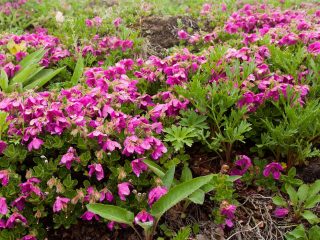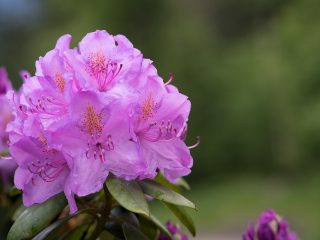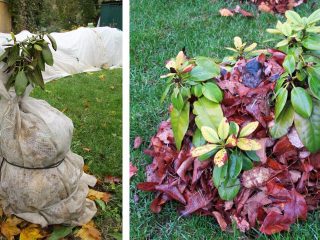Content
The evergreen rhododendron Polarnacht was bred by German breeders in 1976 based on varieties Purple Splendour And Turkana. The plant is unpretentious in care and frost-resistant, blooms for about a month - from May to June.
Description of the rhododendron variety Polarnakht
Rhododendron Polarnacht has luscious crimson flowers with ruffled petals. They have a unique feature - depending on the light intensity, they change color to purple. In partial shade the plant is covered with violet-blue, almost black flowers, in the sun - raspberry-purple. It is not for nothing that the name of the variety translated from German means “polar night”.
The height of the bush is up to 1.5 m, the leaves are oval-oblong, glossy, dark green, up to 11 cm long. The crown is round, dense, the flowers are collected in large inflorescences. The bark on the trunk is gray, smooth, young shoots are green. The roots of the plant are located superficially, they have a fibrous structure, and grow in symbiosis with mycorrhiza.
Winter hardiness of rhododendron Polarnacht
According to gardeners, the Polarnacht rhododendron has good winter hardiness and is suitable for growing in frost resistance zone 5. These are regions where the temperature in winter does not drop below -29 °C. If it is much colder in winter, it is better to choose another, more frost-resistant variety or build a frame shelter for the plant. It will help the Polarnacht rhododendron survive frosts and bright scorching sun in February-March.
The root zone of the shrub is protected with mulch after water-recharging autumn watering. In the spring, the protective cover is removed in cloudy weather, after watering the rhododendron, the mulch is carefully raked from the base of the bush until the soil warms up.
Conditions for growing hybrid rhododendron Polarnacht
The evergreen Polarnacht rhododendron should grow in a place sheltered from the winds, in partial shade. The success of growing this ornamental shrub depends on the correct selection and preparation of the site before planting. Annual care will not cause difficulties - the plant needs to be watered 2-3 times a week, pouring at least 10 liters of water under the bush. For lush flowering, feeding with a special fertilizer is important. If winters in the region are cold, the Polarnacht rhododendron is covered with spunbond, constructing an air-dry shelter.
Planting and caring for rhododendron Polarnacht
There are no particular difficulties in caring for Polarnacht rhododendron. It is only necessary to maintain the acidity of the soil at a level comfortable for the plant, to water and mulch the tree trunk in a timely manner. Sometimes the soil under the plant becomes compacted, which can lead to chlorosis. To loosen the soil, step back 30 cm from the crown and pierce the ground with a pitchfork, making punctures at a distance of 15 cm from each other around the entire bush. River sand is poured into the punctures and watered.
Selection and preparation of a landing site
For the Polarnacht rhododendron, shown in the photo below, a place in partial shade, protected from the wind, is suitable. It grows well on the north side of buildings, where it is difficult to grow other plants. It can be planted under the canopy of evergreen pines and spruces, where it will bloom annually.
Planting Tips:
- Rhododendron Polarnacht prefers acidic soil and will not live in any other soil.
- The root system of the plant is superficial, but a hole is prepared two spade deep in order to fill it with an acidic soil substrate.
- To plant Polarnacht rhododendron, equal parts of acidic peat, soil and coniferous litter from a pine forest are mixed.
- Fill the planting hole with the prepared substrate, then plant the rhododendron.
Seedling preparation
When choosing a seedling, buy a specimen that has several flowers and a large number of buds. It is better that the plant is grown in the local climate and survives at least one winter. Lush seedlings, all covered with flowers, go on sale from greenhouses; they look beautiful, but take root in open ground with difficulty.
Before planting, the Polarnacht rhododendron is removed from the planting container along with a lump of earth. Soak in a container with water, adding the drug “Mycorrhiza” or “Zircon” and “Kornevin” for 5-10 minutes. Then the root ball is squeezed out of moisture and planted in the prepared hole.
Landing rules
When placed in a planting hole, the root ball of the seedling should protrude 2-3 cm above the surface; as the soil sinks, it will settle. Cover the roots with soil and water them with water. The top must be mulched with acidic peat or pine litter with a layer of 5 cm. At the end of planting, you can water the plant with the solution in which it was soaked. When the water is absorbed, add a little more mulch. Further care consists of regular watering, sprinkling on the leaves in the evening or early morning.
Watering and fertilizing
Caring for a planted Polarnacht rhododendron comes down mainly to watering. If it's hot, water the plant at least twice a week. With a lack of moisture, the superficial root system quickly dries out, and the shrub can shed its leaves, which will not look very beautiful. Under normal conditions, the green leaves of rhododendron live for at least two years, then being replaced by new ones.
Rhododendron Polarnacht blooms in May, so it needs spring feeding. It is best to use a special fertilizer for azaleas and rhododendrons, which contains all the necessary nutrients and acidifies the soil. When planting buds, fertilize twice with fertilizers containing phosphorus. During the season, it is advisable to fertilize the soil under the rhododendron at least 3-4 times - in early spring, before flowering and after flowering, during the formation of next year's buds.
Trimming
Proper pruning is necessary for annual flowering. It is necessary to remove poorly formed and weak branches, and pinch off faded buds. Then the rhododendron will direct all its forces to the formation of new inflorescences.
Preparing for winter
In the fall, water-recharging watering of rhododendrons is mandatory to protect them from winter drying out.Adult plants overwinter well without shelter if the thermometer does not fall below -29 °C. Young rhododendrons need shelter in the first 2-3 years after planting. Before the onset of cold weather, the bushes are pruned, removing all dry and weak branches, and treated with fungicides for prevention.
If you don’t have time to make a frame, you can cover the young bushes with spruce branches and spunbond on top. Before covering, the tree trunk circle is mulched with a layer of acidic peat or pine litter with a layer of 15-20 cm.
Reproduction
Rhododendron Polarnacht, whose photo and description evokes the admiration of gardeners, is propagated by cuttings. Cuttings begin in the summer after flowering, choosing a cloudy day for this so that the cut branches are succulent and take root better. Rooting order:
- The semi-lignified branch is cut and divided into several cuttings, 5-8 cm long. The lower cut is made oblique so as not to confuse it with the top when planting.
- Small-diameter planting containers are filled with a mixture of peat and sand in equal proportions and moistened with Kornevin solution.
- The lower leaf plates of the cuttings that come into contact with the soil are cut off, and the upper ones are shortened slightly to reduce the area of moisture evaporation.
- The prepared shoots are deepened into the soil by 1-2 cm and covered with transparent plastic bottles with the bottom cut off or glass jars.
- Ventilate the greenhouse daily, opening the shelter for 10-15 minutes.
- Keep the cuttings in diffused light, air temperature - +22...+24 °C and humidity - about 100%.
A plant grown from a cutting can bloom a year after planting in open ground.
Diseases and pests
With proper planting and cultivation techniques, Polarnacht rhododendron does not get sick and is rarely attacked by pests. Specimens planted in the sun are more likely to suffer. Weakened plants have reduced immunity, they are significantly stunted in growth and may get sick, especially in the spring after the cover is removed.
Common diseases of rhododendrons:
- tracheomycosis wilt;
- bacterial root cancer;
- gray rot;
- late blight of roots;
- rust;
- cercospora;
- chlorosis.
All of the listed diseases, except chlorosis, are treated with Bordeaux mixture or 0.2% Fundazol.
Chlorosis of rhododendrons is a non-parasitic disease; it occurs from a lack of iron; plants cannot absorb it if the soil is insufficiently acidic and is excessively compacted. The first sign of damage is yellowing of the tissue between the veins. For treatment, prepare a solution by adding Zircon and Ferovit to the water according to the instructions. Treatment of leaves is carried out twice with an interval of 10 days.
The following pests can be found on weakened rhododendrons:
- spider mite;
- tobacco thrips;
- whitefly;
- furrow weevil;
- acacia false scale;
- rhododendron mite.
Treatments with Fitoverm, Actellik, Karbofos and other insectoacaricides are effective against insects and ticks.
Conclusion
Rhododendron Polarnacht is highly decorative. This small compact shrub is completely covered with flowers during flowering. The unusual color of the corollas attracts attention - crimson-violet, very bright, it goes well with evergreen conifers, in the shade of which the evergreen rhododendron Polarnacht loves to grow.












https://mygarden-en.desigusxpro.com/sad-i-ogorod/dekorativnye-kustarniki/rododendron-katevbinskiy-rozeum-elegans-kanningems-uayt.html
Good afternoon
Katevbinsky rhododendron is not one variety, but several dozen.Among them there are evergreens and those that shed their leaves for the winter. Therefore, it is advisable to first find out exactly the name of the variety, its description and characteristics.
In general, all varieties of Katevba rhododendron have good frost resistance. However, this does not mean that they do not require care. In the fall, you need to properly prepare the rhododendron for winter. You can learn about this from this article.
The article is great. My Katevbinsky rhododendron has lost a lot of leaves this year before winter... can it freeze? (It is more than 2 meters in height)